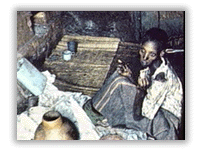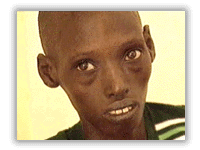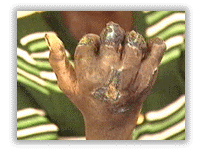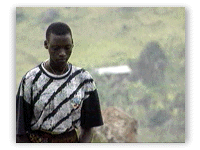by Fergal Keane. Reprinted with permission from the Sunday Times.
Copyright 1997. All rights reserved.
[Federal law provides severe civil and criminal penalties for the unauthorized
reproduction, distribution, or exhibition of copyrighted materials.]
 When I first saw her nearly three years ago she seemed more shadowlike than
human, a skeletal apparition lying on a camp bed in a country where corpses
littered the roads and fields.
When I first saw her nearly three years ago she seemed more shadowlike than
human, a skeletal apparition lying on a camp bed in a country where corpses
littered the roads and fields.
Her hand had been chopped in half and the wound had become infected. It had
taken on an ominous black colour. In addition, there were two deep gashes on
the back of her head. There were no painkillers or anaesthetics in the little
room she shared with three other children. When it came to the time for
changing her dressings the girl winced and cried in pain. I gave the nurse my
stock of paracetamol and a bag of sweets. It was a pitifully inadequate
offering but the only comfort I could give.
The nurse told me the child's name was Valentina. She was 13 and her family had
been killed in a massacre carried out by Hutu soldiers and a militiamen a few
weeks before in the nearby parish of Nyarubuye. Valentina was among a small
group of survivors. "She will probably die," the nurse said.
I left Rwanda shortly afterwards vowing never to go back. In a few weeks I had
witnessed brutality and evil on a terrifying scale. Nothing could have prepared
me for the immensity of the killings or the hatred I encountered among those
who had carried out the genocide.
However, Rwanda did not go away, nor did the memory of Valentina and the other
survivors of genocide. I found myself endlessly questioning: how could this
have happened? How could people butcher children? What kind of man can kill a
child?
I was still in search of the answer three years later when I returned. The
country had changed dramatically. The schools had been reopened and the fields
were full of peasants harvesting their crops. The sound of shooting had been
replaced by the ancient chorus of African village life: crying babies,
whinnying goats and the interminable crowing of roosters.
The church that had been the focal point of the massacre had been cleaned up,
the bodies removed and placed in a series of rooms nearby. These rooms had also
been the scene of particularly brutal killings. Now the government was
preserving them, replete with skeletons and mouldering corpses, as a memorial
to genocide.
 Within minutes of arriving at Nyarubuye I learnt Valentina had not died.
Shortly after I had last seen her she had been transferred to a hospital and,
against the medical odds, survived her injuries. Now, meeting her in front of
the church, I saw a tall and beautiful 16-year-old nothing like the emaciated
child of three years previously. But before long I realised that this new
appearance was deceptive. As Valentina patiently told me her full, terrible
story I found myself wavering between shock and anger.
Within minutes of arriving at Nyarubuye I learnt Valentina had not died.
Shortly after I had last seen her she had been transferred to a hospital and,
against the medical odds, survived her injuries. Now, meeting her in front of
the church, I saw a tall and beautiful 16-year-old nothing like the emaciated
child of three years previously. But before long I realised that this new
appearance was deceptive. As Valentina patiently told me her full, terrible
story I found myself wavering between shock and anger.
The story of what happened at the church of Nyarubuye is more than a
straightforward commentary on humanity's capacity for evil. It is a very
particular story about the cruelty inflicted upon children by adults, people
who were their neighbours and whom they trusted.
It began on a Friday afternoon in the middle of April. For days the Tutsis of
Nyarubuye had sensed am impending disaster. The were aware that elsewhere in
the country massacres of Tutsis had already begun. Ten days previously, Juvenal
Habyarimana, the president of Rwanda, had been assassinated, most probably by
members of his political circle.
Although he was a Hutu, Habyarimana was seen as having become weak in his
dealings with the Tutsis and the moderate Hutus opposition groups. The
extremists feared the power-sharing agreement signed by Habyarimana would see
the erosion of their power and financial privilege.
His death--which the extremists blamed on the Tutsis--provided the pretext for
a "final solution" in which all Tutsis and Hutu moderates were to be killed. It
would result in the murder of all but a handful of Nyarubuye's Tutsi
community.
The killing at Nyarubuye began with an attack on Tutsis at the local
marketplace. After this Valentina fled to the church with her family. That
afternoon the killers arrived, led by Sylvestre Gacumbitsi, the local mayor.
Valentina recognised many of her Hutu neighbours among the more than 30 men who
surrounded the church. They carried knives and clubs and were supported by
soldiers from the Rwandan army.
Among the gang of men was Denis Bagaruka, a 56-year-old grandfather whose own
children went to school with Valentina.
She described what happened next: " First they asked people to hand over their
money, saying they would spare those who paid. But after taking the money they
killed them anyway. then they started to throw grenades. I saw a man blown up
in the air, in pieces, by a grenade. The leader said that we were snakes and
that to kill snakes you had to smash their heads.
The killers moved into the terrified crowd of men, women and children, hacking
and clubbing as they went. "If they found someone alive they would smash their
heads with stones. I saw them take little children and smash their heads
together until they were dead. There were children begging for pity but they
killed them straight away," she told me. The killings took place over four
days. At night the butchers rested and, guarding the perimeter so that nobody
would escape.
Other infants, crying on the ground beside their murdered parents, were taken
and plunged head first into latrines. One of Valentina's classmates, and
angel-faced little boy named Placide, told me how he had seen a man decapitated
in front of him and then a pregnant woman cut open as the killing reached its
frenzied climax.
"There was so much noise," he recalled. "People were begging for mercy and you
could hear the militia saying, 'Catch them, catch them, don't let them get
away.'"
 Valentina and Placide hid among the bodies, pretending to be dead. Valentina
had been struck on the head and hands with a machete and was bleeding heavily.
Following her child's instinct, she crawled to her mother's body and lay there.
During the killing she had seen the militia murder her father and her
16-year-old brother, Frodise.
Valentina and Placide hid among the bodies, pretending to be dead. Valentina
had been struck on the head and hands with a machete and was bleeding heavily.
Following her child's instinct, she crawled to her mother's body and lay there.
During the killing she had seen the militia murder her father and her
16-year-old brother, Frodise.
After several days Valentina crawled to the room where there were fewest
bodies. For the next 43 days she lived among the rotting corpses, too weak to
stand up and convinced that the world had come to an end.
"I prayed that I would die because I could not see a future life. I did not
think that anybody was left alive in the country. I thought everybody had been
swept away," she said.
She drank rainwater and rummaged for scraps of food. There was some wild fruit
and some grain but she became weaker and weaker as the days progressed. In the
weeks that followed, a few other children emerged from hiding places around the
church. The stronger ones lit fires and cooked what food they could find,
feeding the weaker ones like Valentina.
Then a new hazard appeared: wild dogs that had started to eat the corpses.
"The dogs were coming at night and eating dead children in the other rooms. A
dog came to where I was and started to eat a body. I picked up a stone and
threw it at the dog and drove it away."
There comes a point in the telling of this story where the existing vocabulary
of suffering becomes inadequate, where words wither in the face of an
unrelenting darkness. As a reporter I found this the most difficult story of my
career to tell. As a parent I listened to Valentina's story with a sense of
heartbreak. I marvelled at her courage but felt deep anger that his should
happen to any child. It was difficult to keep those feelings in check when I
confronted one of the butchers of Nyarubuye in the office of the local
prosecutor.
Bagaruka, the grandfather who witnesses say was an enthusiastic killer, had
recently returned from Tanzania. He had spent nearly three years there in the
refugee camp at Benaco where he and his family were fed and cared for by the
international community. The man who had helped to bring terror to the infants
of Nyarubuye was nervous and evasive when I spoke to him.
"You have eight children, how in God's name can you help to kill a child?" I
asked him. After a long pause he answered: "You see all those people in the
church had children. Many were carrying them on their backs but none survived.
Everyone was killed. We couldn't spare the children's lives. Our orders were to
kill everyone."
He told me that he himself had been an orphan and a Tutsi man had been his
guardian. Bagaruka had seen the man killed at Nyarubuye. "I almost become crazy
when I think about that," he said.
Bagaruka has confessed to some of his crimes and has implicated some of his
friends and neighbours, hoping to save himself from the firing squad.
 Valentina hopes he will never return to the village. She now lives with an aunt
and two other orphans. The aunt's husband and three children were killed at
Nyarubuye.
Valentina hopes he will never return to the village. She now lives with an aunt
and two other orphans. The aunt's husband and three children were killed at
Nyarubuye.
The aunt told me that Valentina has a recurring dream. She imagines her mother
coming in the middle of the night. They embrace and then Valentina shows her
mutilated hand to her mother, saying: "Mother, look what's become of me. Look
what has happened to me." And Valentina wakes up crying and sees that her
mother has vanished into the darkness. Then she remembers that her mother is
dead and gone forever.